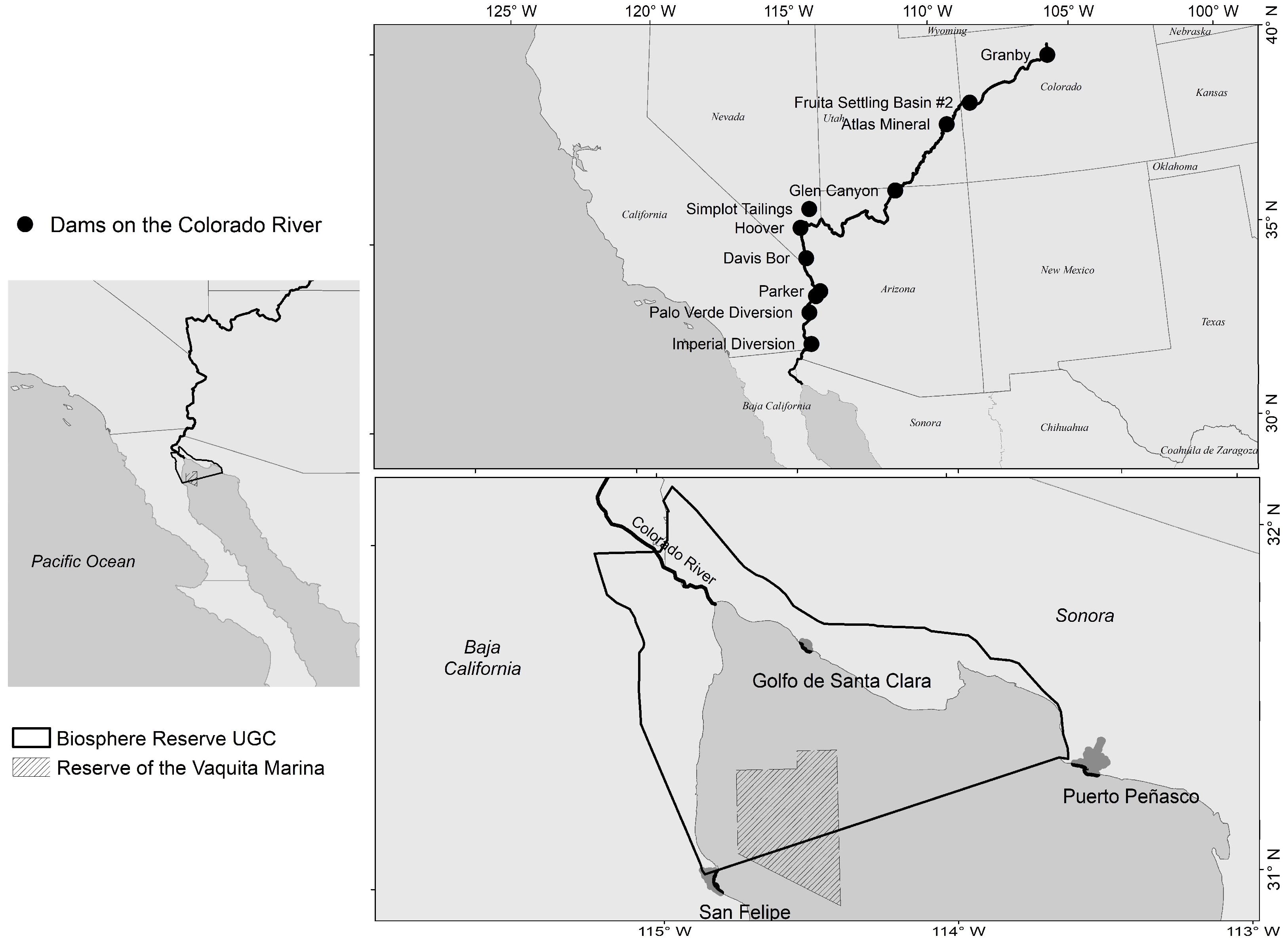Applying SPOT Images to Study the Colorado River Effects on the Upper Gulf of California †
Abstract
:1. Introduction
2. Material and Methods
2.1. Study Area
2.2. Image Processing
- (1)
- Neap tide (during the first and third quarter moon, when the moon appears “half full”, the sun and moon are at right angles to each other; the bulge of the ocean caused by the sun partially cancels out the bulge of the ocean caused by the moon) in flow (slow and continuous rise of the waters) or ebb flow (slow and continuous descent of the waters)
- (2)
- Spring tide (new and full moon; the moon and sun are aligned and their effects are added) in flow or ebb flow
- (3)
- Season, warm or cold season.
3. Results and Discussion
Acknowledgments
Author Contributions
Conflicts of Interest
References
- Mueller, E.R.; Schmidt, J.C.; Topping, D.J.; Shafroth, P.B.; Rodríguez-Burgueño, J.E.; Ramírez-Hernández, J.; Grams, P.E. Geomorphic change and sediment transport during a small artificial flood in a transformed post-dam delta: The Colorado River delta, United States and Mexico. Ecol. Eng. 2017, 106, 757–775. [Google Scholar] [CrossRef]
- Shumilin, E.N.; Carriquiry, J.D.; Camacho-Ibar, V.F.; Sapozhnikov, D.; Kalmykov, S.; Sánchez, A.; Aguíñiga-García, S.; Sapozhnikov, Y.A. Spatial and vertical distributions of elements in sediments of the Colorado River delta and Upper Gulf of California. Mar. Chem. 2002, 79, 113–131. [Google Scholar] [CrossRef]
- Zamora, H.A.; Nelson, S.M.; Flessa, K.W.; Nomura, R. Post-dam sediment dynamics and processes in the Colorado River estuary: Implications for habitat restoration. Ecol. Eng. 2013, 59, 134–143. [Google Scholar] [CrossRef]
- Orozco-Durán, A.; Daesslé, L.W.; Camacho-Ibar, V.F.; Ortiz-Campos, E.; Barth, J.A.C. Turnover and release of P-, N-, Si-nutrients in the Mexicali Valley (Mexico): Interactions between the lower Colorado River and adjacent ground- and surface water systems. Sci. Total Environ. 2015, 512–513, 185–193. [Google Scholar] [CrossRef] [PubMed]
- Millán Núñez, R.; Santamaría-del-Ángel, E.; Cajal-Medrano, R.; Barocio-León, O.A. El delta del Río Colorado: Un ecosistema con alta productividad primaria. Cienc. Mar. 1999, 25, 509–540. [Google Scholar] [CrossRef]
- Daesslé, L.W.; Orozco, A.; Struck, U.; Camacho-Ibar, V.F.; van Geldern, R.; Santamaría-del-Angel, E.; Barth, J.A.C. Sources and sinks of nutrients and organic carbon during the 2014 pulse flow of the Colorado River into Mexico. Ecol. Eng. 2017, 106, 799–808. [Google Scholar] [CrossRef]
- Duval, D.; Colby, B. The influence of Colorado River flows on the upper Gulf of California fisheries economy. Ecol. Eng. 2017, 106, 791–798. [Google Scholar] [CrossRef]
- Ramirez-Leon, M.R.; Álvarez-Borrego, S.; Turrent Thompson, C.; Gaxiola Castro, G.; Heckel Dziendzielewski, G. Nutrient input from the Colorado River to the northern Gulf of California is not required to maintain a productive pelagic ecosystem. Cienc. Mar. 2015, 41, 169–188. [Google Scholar] [CrossRef]
- Santamaría-del-Ángel, E.; Millán-Núñez, R.; González-Silvera, A.; Callejas-Jiménez, M.; Cajal-Medrano, R.; Galindo-Bect, M. The response of shrimp fisheries to climate variability of Baja California, México. ICES J. Mar. Sci. 2011, 68, 766–772. [Google Scholar] [CrossRef]
- Santamaría-del-Ángel, E.; Aguilar-Maldonado, J.A.; Galindo-Bect, M.S.; Sebastiá-Frasquet, M.T. Marine Spatial Planning: Protected Species and Social Conflict in the Upper Gulf of California. In Marine Spatial Planning: Methodologies, Environmental Issues and Current Trends, 1st ed.; Kitsiou, D., Karydis, M., Eds.; Nova Science Publishers: Hauppauge, NY, USA, 2017; ISBN 978-1-53612-183-4. [Google Scholar]
- Lavín, M.; Castro, R.; Beier, E.; Cabrera, C.; Godínez, V.; Amador-Buenrostro, A. Surface circulation in the Gulf of California in summer from Surface drifters and satellite images (2004–2006). J. Geophys. Res. Oceans 2014, 119, 4278–4290. [Google Scholar] [CrossRef]
- Nelson, S.M.; Ramírez-Hernández, J.; Rodríguez-Burgueño, J.E.; Milliken, J.; Kennedy, J.R.; Zamora-Arroyo, F.; Schlatter, K.; Santiago-Serrano, E.; Carrera-Villa, E. A history of the 2014 Minute 319 environmental pulse flow as documented by field measurements and satellite imagery. Ecol. Eng. 2017, 106, 733–748. [Google Scholar] [CrossRef]
- Aguilar-Maldonado, J.A.; Santamaría-del-Ángel, E.; Sebastiá-Frasquet, M.T. Reflectances of SPOT multispectral images associated with the turbidity of the Upper Gulf of California. Rev. Teledetec. 2017. (under review). [Google Scholar] [CrossRef]




Publisher’s Note: MDPI stays neutral with regard to jurisdictional claims in published maps and institutional affiliations. |
© 2018 by the authors. Licensee MDPI, Basel, Switzerland. This article is an open access article distributed under the terms and conditions of the Creative Commons Attribution (CC BY) license (https://creativecommons.org/licenses/by/4.0/).
Share and Cite
Aguilar-Maldonado, J.A.; Santamaría-del-Ángel, E.; Sebastiá-Frasquet, M.-T. Applying SPOT Images to Study the Colorado River Effects on the Upper Gulf of California. Proceedings 2018, 2, 182. https://doi.org/10.3390/ecws-2-04951
Aguilar-Maldonado JA, Santamaría-del-Ángel E, Sebastiá-Frasquet M-T. Applying SPOT Images to Study the Colorado River Effects on the Upper Gulf of California. Proceedings. 2018; 2(5):182. https://doi.org/10.3390/ecws-2-04951
Chicago/Turabian StyleAguilar-Maldonado, Jesús A., Eduardo Santamaría-del-Ángel, and María-Teresa Sebastiá-Frasquet. 2018. "Applying SPOT Images to Study the Colorado River Effects on the Upper Gulf of California" Proceedings 2, no. 5: 182. https://doi.org/10.3390/ecws-2-04951
APA StyleAguilar-Maldonado, J. A., Santamaría-del-Ángel, E., & Sebastiá-Frasquet, M.-T. (2018). Applying SPOT Images to Study the Colorado River Effects on the Upper Gulf of California. Proceedings, 2(5), 182. https://doi.org/10.3390/ecws-2-04951





